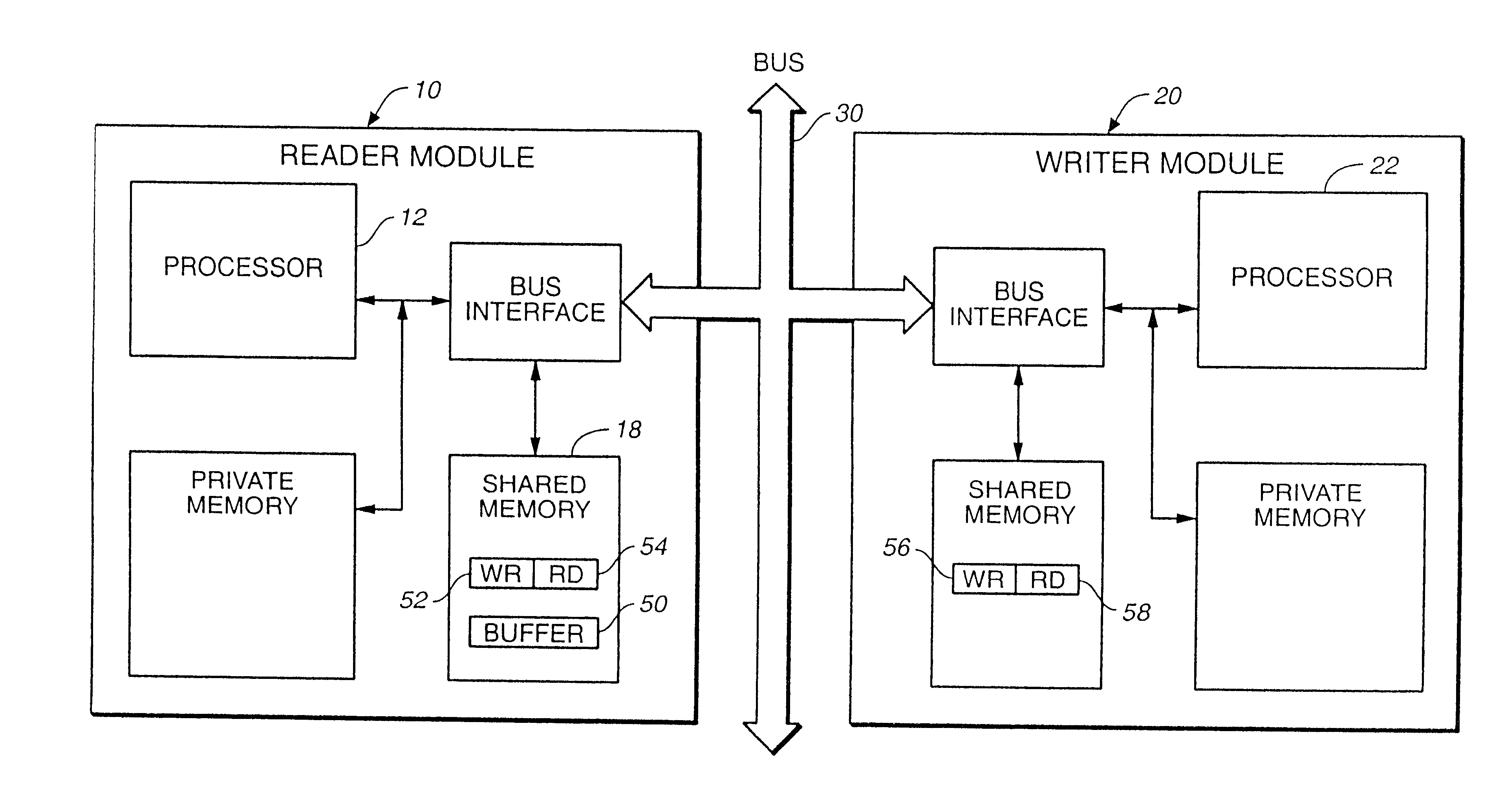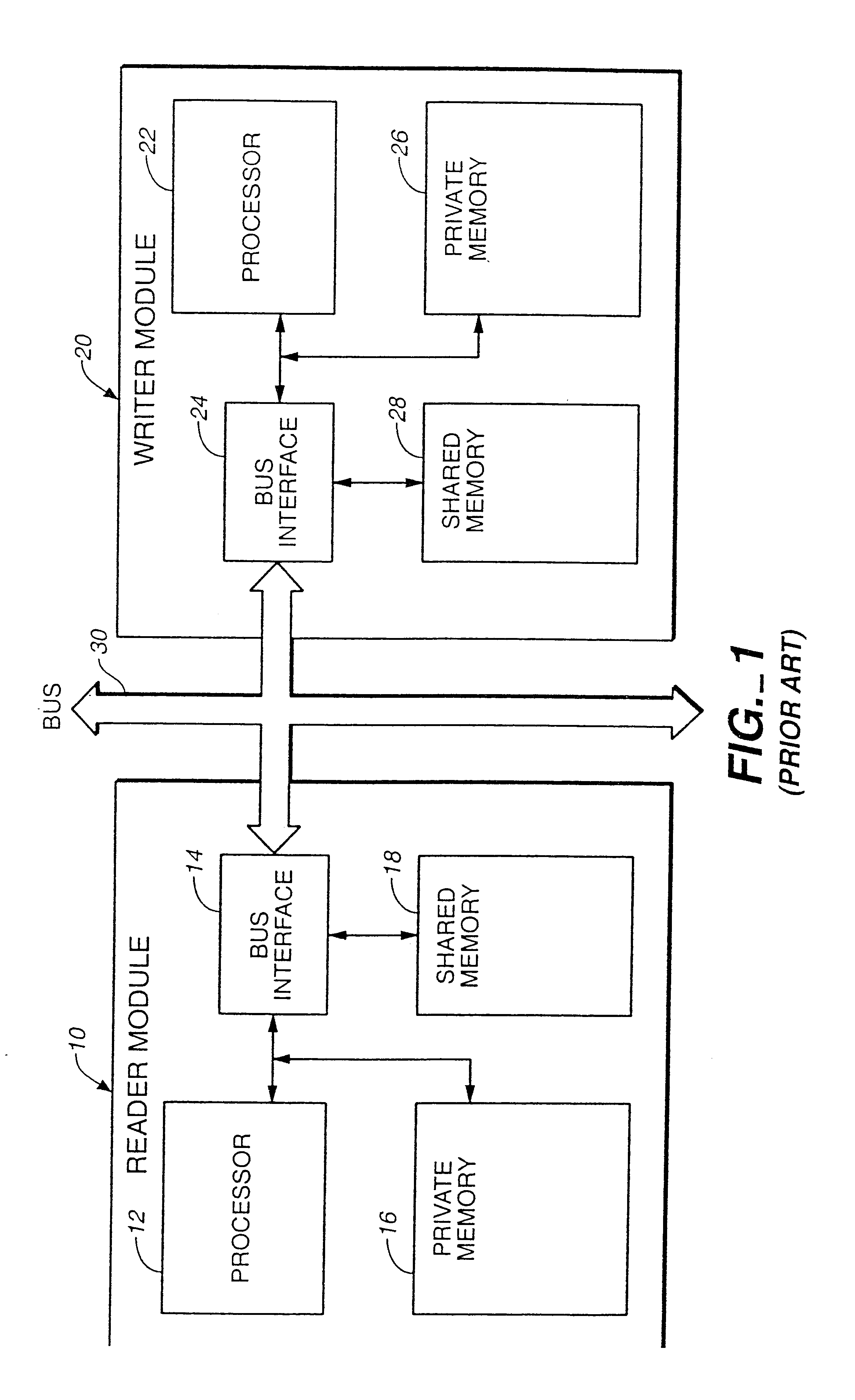Efficient implementation of first-in-first-out memories for multi-processor systems
- Summary
- Abstract
- Description
- Claims
- Application Information
AI Technical Summary
Benefits of technology
Problems solved by technology
Method used
Image
Examples
first embodiment
13 int GetFifo (pFifoDesc_t FifoDesc, pElem_t Elem) 14 { 15 if (FifoDesc->RD == FifoDesc->WR) 16 return 0; 17 *Elem = Fifo[FifoDesc->RD]; 18 If (++FifoDesc->RD == SIZE) 19 FifoDesc->RD = 0; 20 *(FifoDesc->Other) = FifoDesc->RD; / * W(*Other)* / 21 return 1; 22 }
Similarly, the PutFifo routine used by the Writer is as follows:
23 int PutFifo (pFifoDesc_t FifoDesc, Elem_t Elem) 24 { 25 int WR = FifoDesc->WR + 1; 26 if (WR == SIZE) 27 WR = 0; 28 If (WR == FifoDesc->RD) 29 return 0; 30 *(FifoDesc->Other) = WR; / * W(Other) * / 31 FifoDesc->WR = WR; 32 Fifo[FifoDesc->WR] = Elem; / * W(Elem) * / 33 return 1; 34 }
This implementation requires only 3 total writes per data element.
The foregoing implementation may be further improved by splitting the descriptor in half as shown in FIG. 6. For the Writer, the WR pointer is kept in private and not shared memory. The RD pointer is kept in shared memory so that when the Reader module performs a read operation, the Reader module can update the Writer's RD...
second embodiment
1 int GetFifo (pFifoDesc_t FifoDesc, pElem_t Elem) 2 { 3 if (FifoDesc->RD] == Zero 4 return 0; 5 *Elem = Fifo[FifoDesc->RD]; 6 Fifo[FifoDesc->RD] = Zero; 7 If (++FifoDesc->RD == SIZE) 8 FifoDesc->RD = 0; 9 *(FifoDesc->Other) = FifoDesc->RD; / * W(*Other)* / 10 return 1; 11 }
The FIFO buffer is initialized to all Zero. Now, a Reader can check the next FIFO location and if it is Zero, the FIFO is empty. Otherwise, the Reader retrieves the data element and then puts Zero in the FIFO buffer to mark this location as empty. The PutFifo routine for this second embodiment is as follows:
12 int PutFifo (pFifoDesc_t FifoDesc, Elem_t Elem) 13 { 14 int WR = FifoDesc->WR +1 15 if (WR == SIZE) 16 WR = 0; 17 if (WR == FifoDesc->RD) 18 return 0; 19 FifoDesc->WR = WR; 20 Fifo[FifoDesc->WR] = Elem; / *W(Elem)* / 21 return 1; 22 }
In this embodiment, only two Writes across the data bus per data element are required: one Write to write a datum into the buffer during a Write operation, and one Write to update...
third embodiment
1 typedef struct { 2 int Ptr; / *current element to be read* / 3 / * retrieved from Fifo) * / 4 int *Credit; / * pointer to Credit field * / 5 / * in sender memory * / 6 int Count; / * total number of elements * / 7 / * retrieved from the Fifo * / 8 / * or current credit value * / 9 } FifoDesc_t, *pFifoDesc_t; 10 12 Elem_t Fifo[SIZE] 13 int GetFifo (pFifoDesc_t FifoDesc, pElem_t Elem) 14 { 15 if (Fifo[FifoDesc->Ptr] == Zero 16 return 0; 17 *Elem = Fifo[FifoDesc->Ptr]; 18 Fifo[FifoDesc->Ptr] = Zero; 19 if (++FifoDesc->Ptr == SIZE) 20 FifoDesc->Ptr = 0; 21 if ((++FifoDesc->Count % (SIZE / 2)) == 0) 22 *FifoDesc->Credit = FifoDesc->Count; 23 / * W(*Credit)* / - 24 return 1; 25 } 26 27 int PutFifo (pFifoDesc_t FifoDesc, Elem_t Elem) 28 { 29 if (*FifoDesc->Credit == FifoDesc->Count) 30 return 0; 31 Fifo[FifoDesc->Ptr = Elem; / * W(Elem)* / 32 if (++FifoDesc->Ptr == SIZE) 33 FifoDesc->Ptr = 0; 34 FifoDesc->Count++; 35 return 1; 36 }
Since the Write at line 22 of GetFifo happens only twice per SIZE invocation...
PUM
 Login to View More
Login to View More Abstract
Description
Claims
Application Information
 Login to View More
Login to View More - R&D
- Intellectual Property
- Life Sciences
- Materials
- Tech Scout
- Unparalleled Data Quality
- Higher Quality Content
- 60% Fewer Hallucinations
Browse by: Latest US Patents, China's latest patents, Technical Efficacy Thesaurus, Application Domain, Technology Topic, Popular Technical Reports.
© 2025 PatSnap. All rights reserved.Legal|Privacy policy|Modern Slavery Act Transparency Statement|Sitemap|About US| Contact US: help@patsnap.com



